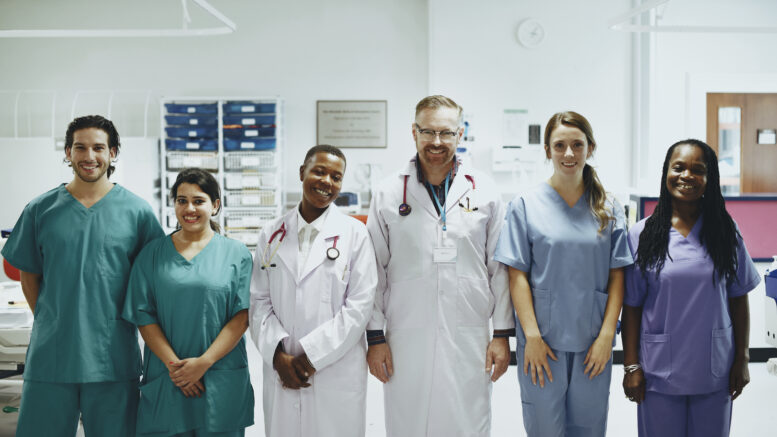Since March of 2020, the COVID-19 pandemic has put an unprecedented strain on the American health care system as large surges of intensive care unit patients overwhelmed hospitals. Facing this challenge, Beth Israel Deaconess Medical Center (BIDMC) expanded ICU capacity by 93 percent and maintained surge conditions during the nine weeks in the spring of 2020.
In a pair of papers and a guest editorial published in Dimensions of Critical Care Nursing, a team of nurse-scientists at Beth Israel Deaconess Medical Center (BIDMC) share their experiences nearly doubling the hospital’s intensive care unit capacity; identifying, training and redeploying staff; and developing and implementing a proning team to manage patients with acute respiratory distress syndrome during the first COVID-19 surge.
“As COVID-19 was sweeping through the nation, we at BIDMC were preparing for the projected influx of highly infectious, critically ill patients,” said lead author Sharon C. O’Donoghue, DNP, RN, a nurse specialist in the medical intensive care units at BIDMC. “It rapidly became apparent that a plan for the arrival of highly infectious critically ill patients as well as a strategy for adequate staffing protecting employees and assuring the public that this could be managed successfully were needed.”
After establishing a hospital incident command structure to clearly define roles, open up lines of communication and develop surge plans, BIDMC leadership began planning for the impending influx of patients with COVID-19 in February 2020.
BIDMC – a 673 licensed bed teaching hospital affiliated with Harvard Medical School – has nine specialty ICUs located on two campuses for a total of 77 ICU beds. Informed by an epidemic surge drill conducted at BIDMC in 2012, leadership determined that the trigger to open extra ICU space would be when 70 ICU beds were occupied. When this milestone was met on March 31, 2020, departmental personnel had a 12-hour window to convert two 36-bed medical-surgical units into additional ICU space, providing an additional 72 beds.
“Because the medical-surgical environment is not designed to deliver an ICU level of care, many modifications needed to be made and the need for distancing only added to the difficulties,” said senior author Susan DeSanto-Madeya, PhD, RN, FAAN, a Beth Israel Hospital Nurses Alumna Association endowed nurse scientist. “Many of these rooms were originally designed for patient privacy and quiet, but a key safety element in critical care is patient visibility, so we modified the spaces to accommodate ICU workflow.”
Modifications included installing windows in all patient room doors, and repositioning beds and monitors so patients and screens could be easily seen without entering the room. Lines of visibility were augmented with mirrors and baby monitor systems as necessary. To further minimize staff exposure to the virus, care providers were given two-way radios to decrease the number of staff required to enter a room when hands-on patient care was necessary. Mobile supply carts and workstations helped improved overall workflow efficiency.
In addition to stockpiling and managing medical equipment including personal protective equipment (PPE), ventilators and oxygen, increasing ICU capacity also required redeploying 150 staff trained in critical care. The hospital developed a recall list for former ICU nurses. Further, medical-surgical nurses that could bring their skills to care for critically ill patients on teams with veteran ICU nurses were also identified.
Redeployment of staff required education and support. In-person, socially-distanced workshops were developed for each group, after which nurses were assigned to shadow an ICU nurse to reduce anxiety, practice new skills and gain confidence.
“Staff identified the shadow experience as being most beneficial in preparing them for deployment during the COVID-19 surge,” said O’Donoghue. “Historically, BIDMC has had strong collaborative relationships with staff from different areas and these relationships proved to be vital to the success of all the care teams. The social work department played a major role in fostering teams, especially during difficult situations.”
One of the redeployment teams was the ICU proning team, brought together to support bedside clinicians by facilitating safe and timely prone positioning. Proning is an intervention known to improve oxygenation in patients with acute respiratory distress syndrome – a key feature of severe COVID-19 – that is complex, takes time and is not without its potential dangers to the patient and staff alike. The coalition maximized resources and facilitated more than 160 interventions between March and May of 2020.
“Although the pandemic was an unprecedented occurrence, it has prepared us for potential future crises requiring the collaboration of multidisciplinary teams to ensure optimal outcomes in an overextended environment,” O’Donoghue said. “BIDMC’s staff rose to the challenge, and many positive lessons were learned from this difficult experience.”
“We must continue to be vigilant in our assessment of what worked and what did not work and look for ways to improve health care delivery in all our systems,” said DeSanto-Madeya, who is also an associate professor at the College of Nursing at the University of Rhode Island. “The memories from this past year and a half cannot be forgotten, and we can move forward confidently knowing we provided the best care possible despite all the hardships.”
Co-authors included Jacqueline Hardman, BSN, RN; Joanna Anderson, BSN, RN, CCRN, CNRN; Jane Foley, DNP, RN; Jean Gillis, MSN, RN; Kimberly Maloof, MSN, RN; Andrea Milano, MSN, RN, CCRN, CMC; John Whitlock, MS, RN; Meghan Church, DPT; Kristin Russell, BSN, RN; Kelly A. Gamboa, DNP, RN, CNOR; Jennifer Sarge, BSN, RN, Ari Moskowitz, MD; Margaret M. Hayes, MD, ATSF; and Michael N. Cocchi, MD, of BIDMC.
Source: Beth Israel Deaconess Medical Center
